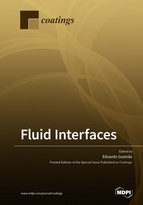Fluid Interfaces
A special issue of Coatings (ISSN 2079-6412). This special issue belongs to the section "Liquid–Fluid Coatings, Surfaces and Interfaces".
Deadline for manuscript submissions: closed (30 September 2020) | Viewed by 40443
Special Issue Editor
Interests: polyelectrolyte; surfactants; interfaces; polymer; layer by layer; colloids; emulsions; interfacial rheology; biophysics
Special Issues, Collections and Topics in MDPI journals
Special Issue Information
Dear Colleagues,
Fluid interfaces are promising candidates for confining different types of materials, for example, polymers, surfactants, colloids, or even small molecules, by direct spreading or self-assembly from solutions in the design of new functional materials. The development of such materials requires a deepening on the physico-chemical bases underlying the formation of layers at fluid interfaces, as well as on the characterization of their structures and properties. This is of particular importance, because the constrains associated with the assembly of materials at the interface lead to the emergence of equilibrium and dynamics features in the interfacial systems, which are far from those conventionally found in the traditional materials. These new properties are of importance in many scientific and technological fiels, such as food science, cosmetics, biology, oil recovery, electronic, drug delivey, detergency, and tissue engineering. Therefore, an understanding of the theoretical and practical aspects involved in the preparation of these interfacial systems to improve on their usage for designing new technological systems are of paramount importance. This Special Issue is devoted to the fundamental and applied aspects involved in the study of fluid interfaces, with the aim of providing a comprehensive perspective on the current status of the research field. It is expected that this will help to provide a bridge between the most fundamental knowledge on fluid interface, and the development of new applications based on it, closing the gap between different views.
Dr. Eduardo GuzmánGuest Editor
Manuscript Submission Information
Manuscripts should be submitted online at www.mdpi.com by registering and logging in to this website. Once you are registered, click here to go to the submission form. Manuscripts can be submitted until the deadline. All submissions that pass pre-check are peer-reviewed. Accepted papers will be published continuously in the journal (as soon as accepted) and will be listed together on the special issue website. Research articles, review articles as well as short communications are invited. For planned papers, a title and short abstract (about 100 words) can be sent to the Editorial Office for announcement on this website.
Submitted manuscripts should not have been published previously, nor be under consideration for publication elsewhere (except conference proceedings papers). All manuscripts are thoroughly refereed through a single-blind peer-review process. A guide for authors and other relevant information for submission of manuscripts is available on the Instructions for Authors page. Coatings is an international peer-reviewed open access monthly journal published by MDPI.
Please visit the Instructions for Authors page before submitting a manuscript. The Article Processing Charge (APC) for publication in this open access journal is 2600 CHF (Swiss Francs). Submitted papers should be well formatted and use good English. Authors may use MDPI's English editing service prior to publication or during author revisions.
Keywords
- interfaces
- confinenent
- dynamics
- materials
- applications






